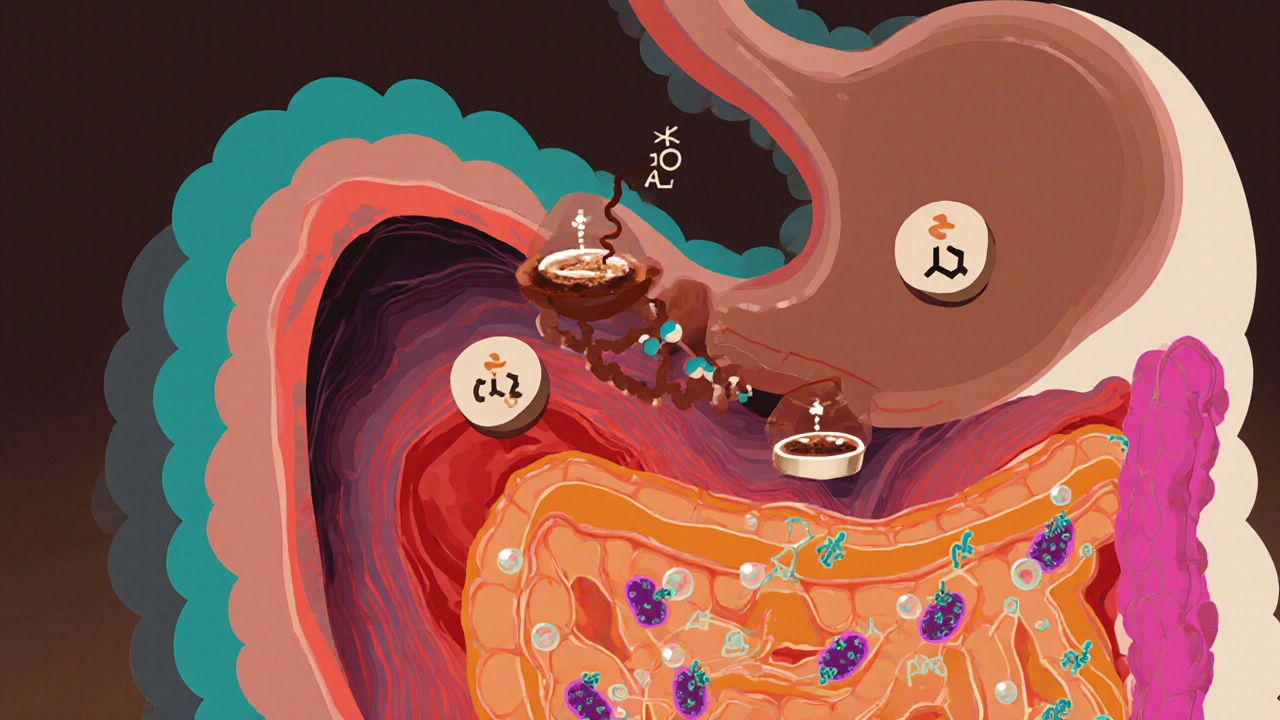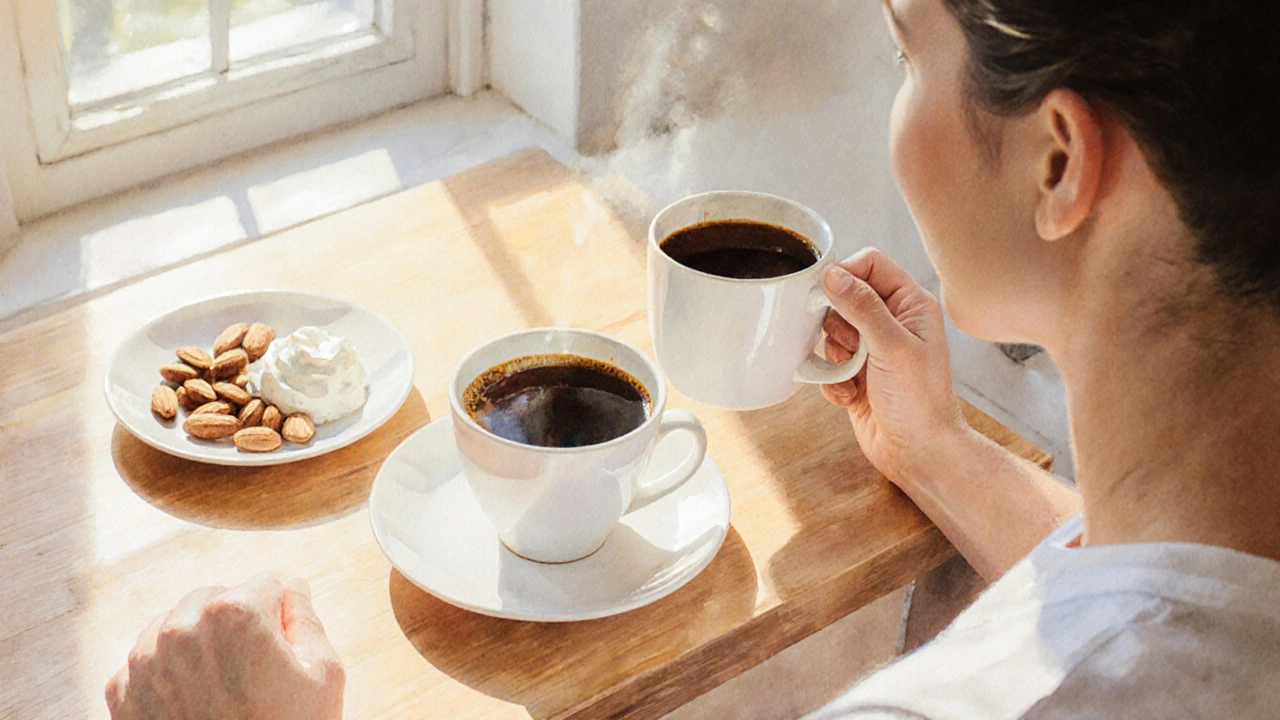Coffee Flatulence Impact Calculator
Light
High AcidMedium
Medium AcidDark
Low AcidDecaf
Low CaffeineEnter your coffee preferences and click "Analyze My Coffee Impact" to see how they affect your flatulence risk.
- Choose dark roasts for lower acidity
- Drink coffee with food to slow gastric emptying
- Limit intake to 1-2 cups daily
- Try cold brew for reduced acid extraction
Quick Summary / Key Takeaways
- Both caffeine and coffee acids can stimulate stomach secretions, which may increase or decrease gas depending on individual tolerance.
- Dark roasts tend to be less acidic than light roasts, often causing fewer episodes of bloating.
- Timing matters - drinking coffee on an empty stomach can amplify gas, while pairing it with food can blunt the effect.
- Adjusting brew methods, roast level, and portion size can help you enjoy coffee without the extra flatulence.
- If gas persists despite tweaks, it could signal an underlying digestive issue that warrants a professional check.
Most of us reach for a hot cup of coffee as soon as the alarm goes off, but have you ever noticed a sudden rise in belly rumblings right after? That uncomfortable feeling isn’t just a coincidence. The chemicals in coffee interact with the gut in several ways, and the result can be more gas than you’d like. Below we break down the science, point out the biggest culprits, and give practical tips so you can keep your morning ritual flat‑ulence‑free.
What Exactly Is Flatulence?
Flatulence is the release of intestinal gas through the rectum, often accompanied by a feeling of bloating or abdominal pressure. Common causes include swallowed air, fermentation of undigested food, and the activity of gut bacteria.
While an occasional puff is normal, excessive flatulence can be a sign that something in your diet-or your digestive system-is out of balance. Coffee is one food that shows up repeatedly in people’s diaries when they log gas episodes.
How Coffee Enters the Digestive Equation
Coffee a brewed beverage made from roasted Arabica or Robusta beans, containing caffeine, chlorogenic acids, and numerous volatile compounds lands in the stomach within minutes of sipping. From there, it triggers three main pathways that can influence gas production:
- Stimulation of stomach acid - Coffee signals the pancreas and stomach lining to secrete more hydrochloric acid (HCl), which can speed up protein breakdown but also irritate the gut lining.
- Caffeine’s impact on gut motility - The stimulant can speed up colon transit, sometimes leading to incomplete digestion and fermentation.
- Acidic compounds - Chlorogenic acids and quinic acid lower the pH of the stomach, which can affect the balance of gut bacteria.
Each pathway has a ripple effect on the gut microbiome the community of trillions of bacteria, archaea, and fungi living in the gastrointestinal tract, which ultimately determines how much gas is produced.

Caffeine: The Double‑Edged Stimulant
Caffeine a bitter alkaloid that acts as a central nervous system stimulant, also influencing smooth muscle activity in the digestive tract is the star of most coffee discussions. Research from the 2023 International Journal of Gastroenterology shows that moderate caffeine (about 100mg, roughly one cup) can increase colon motility by up to 20%.
Faster motility means food spends less time in the small intestine, potentially leading to more undigested carbohydrates reaching the colon where bacteria ferment them, releasing hydrogen, methane, and carbon dioxide - the gases we feel as flatulence.
However, caffeine also relaxes the lower esophageal sphincter, which can allow tiny amounts of air to be swallowed, adding to the gas load.
Acidic Compounds and Their Role
Beyond caffeine, coffee contains a suite of acids:
- Chlorogenic acids - Antioxidants that, when broken down during roasting, become quinic acid.
- Quinic acid - Gives coffee its characteristic tang and can increase stomach acidity.
Roast Level Matters: Light vs. Dark
Roasting changes the chemical profile dramatically. Light roasts preserve most of the chlorogenic and quinic acids, while dark roasts break them down, resulting in a smoother, less acidic cup.
| Roast | Acid Content | Caffeine (mg per 8oz) | Flatulence Score |
|---|---|---|---|
| Light | High | 95 | 8 |
| Medium | Medium | 85 | 5 |
| Dark | Low | 80 | 3 |
| Decaf | Low‑Medium | 2‑5 | 2 |
As the table shows, dark roasts tend to cause fewer gas episodes, partly because the reduced acid load eases stomach irritation.
Digestive Enzymes: The Unsung Heroes
When coffee speeds up transit, the body’s natural digestive enzymes proteins like amylase, lipase, and proteases that break down carbohydrates, fats, and proteins in the small intestine may not get enough time to act. This leaves more carbs for the colon’s bacteria to ferment, creating extra gas.
People with lactase deficiency (common in many adults) can experience a spike in flatulence after adding milk or cream to coffee, because the lactose also reaches the colon undigested.

Practical Tips to Keep Coffee‑Induced Gas at Bay
- Choose a darker roast. The lower acid content reduces stomach irritation.
- Watch the timing. Pair coffee with a small protein‑rich snack (e.g., yogurt, nuts) to slow gastric emptying.
- Mind the quantity. Stick to one 8‑oz cup in the morning; a second cup later can overload the gut.
- Experiment with brewing methods. Cold brew is naturally less acidic than espresso or drip coffee.
- Skip dairy if lactose‑intolerant. Use plant‑based milks that are low in FODMAPs, such as almond or oat (in moderation).
- Consider enzyme supplements. Over‑the‑counter lactase pills can help if you add milk.
Implement one change at a time and keep a brief journal of symptoms. This targeted approach lets you pinpoint the exact trigger.
When Flatulence Might Signal Something Bigger
Occasional gas after coffee is normal, but if you notice any of the following, it’s time to see a healthcare professional:
- Persistent bloating lasting more than a few hours.
- Accompanying abdominal pain, weight loss, or changes in stool consistency.
- Visible signs of malabsorption, such as frequent diarrhea.
Conditions like irritable bowel syndrome (IBS), small‑intestinal bacterial overgrowth (SIBO), or gallbladder disease can amplify coffee’s effects, and they need tailored treatment.
Bottom Line
Coffee isn’t a universal flatulence trigger, but its blend of caffeine, acids, and rapid gastric stimulation can create a perfect storm for some people. By adjusting roast level, brewing style, and consumption timing, you can keep the benefits of that morning buzz while keeping the gas in check. Remember, your gut is unique-listen to it, tweak your routine, and don’t hesitate to get professional advice if the problem persists.
Frequently Asked Questions
Does decaf coffee cause less gas than regular coffee?
Decaf contains far less caffeine, which means it’s less likely to accelerate colon transit. However, decaf still has acids, so the difference is modest unless you’re highly caffeine‑sensitive.
Can cold brew reduce coffee‑related flatulence?
Cold brew is brewed at low temperatures, which extracts fewer acids. Most drinkers report less stomach irritation and therefore fewer gas episodes when switching to cold brew.
Is it okay to add sugar to coffee if I have gas problems?
Sugar itself isn’t a major gas producer, but if you’re using high‑fructose corn syrup or large amounts of honey, the extra fermentable carbs can fuel colonic bacteria and increase flatulence.
Why does coffee on an empty stomach feel worse?
Empty stomachs allow coffee’s acids and caffeine to hit the gut lining directly, intensifying acid production and speeding up transit. Pairing coffee with food buffers these effects.
Should I avoid coffee if I have IBS?
IBS sufferers often report that coffee worsens symptoms because of its stimulatory effect. However, many find a low‑acid, low‑caffeine option (like a small dark‑roast cold brew) tolerable. Trial and error is key.






Dharmendra Singh
October 9, 2025 AT 17:34Coffee’s acidity can indeed stir up the gut, especially with light roasts.
Choosing a darker roast reduces acid and may keep the flatulence in check.
Pair your brew with a solid breakfast to slow gastric emptying.
Also, consider limiting yourself to one or two cups a day.
If you’re sensitive, a cold‑brew might be gentler on your stomach.
Rocco Abel
October 13, 2025 AT 16:01It’s rather elementary that the brewing method influences the gas output; espresso, with its concentrated extraction, tends to amplify stomach irritation.
The high caffeine surge can accelerate peristalsis, leading to more expulsions.
Meanwhile, the nuanced flavors of a single‑origin light roast are a luxury-if you can tolerate the acidity.
Most casual drinkers overlook that decaf isn’t a panacea; the residual acids still provoke the colon.
In short, the elite understand that moderation and roast selection are the true levers of digestive harmony.
Dawn Mich
October 17, 2025 AT 14:27Spare us the high‑brow lecture and just admit that many of us get gassy regardless of “elite” preferences.
If you think a splash of cold brew solves everything, you’re living in a fantasy.
Your so‑called “nuance” won’t stop the burps.
Eric Sevigny
October 21, 2025 AT 12:54From a practical standpoint, increasing fiber intake alongside your coffee can buffer the acidity.
Adding a banana or oatmeal when you sip helps absorb excess acid.
Also, staying hydrated throughout the day reduces the overall digestive stress.
Experiment with brewing temperature; slightly cooler water extracts fewer irritants.
Glenda Rosa
October 25, 2025 AT 11:21Honestly, the whole “coffee‑flatulence” hype is a circus of nonsense, a smokescreen for people who can’t handle their beans.
Dark roasts are the only civilized choice; anything else is a culinary crime.
If you’re still burping, maybe your gut's just too weak for any caffeine‑induced adventure.
Stop whining and upgrade your brew, you’ll thank me later.
charlise webster
October 29, 2025 AT 09:47While you champion dark roasts, it’s worth noting that individual tolerance varies widely and can’t be dismissed outright.
Suggesting a blanket “upgrade” ignores the nuance of microbiome differences.
Let’s keep the discussion evidence‑based rather than judgmental.
lata Kide
November 2, 2025 AT 08:14OMG, I tried the banana trick and it was a total game‑changer! 🙌
My mornings went from *boom* to 😅 smooth sailing.
Also, I switched to a medium roast with a splash of oat milk and the gas vanished like magic! ✨
Mark Eddinger
November 6, 2025 AT 06:41It is advisable to observe the temporal relationship between caffeine ingestion and gastrointestinal motility.
Empirical studies indicate that a latency of thirty minutes mitigates the peak acid response.
Consequently, scheduling coffee consumption after a balanced meal aligns with optimal digestive physiology.
Adherence to these protocols often results in reduced flatulence.
Francisco Garcia
November 10, 2025 AT 05:07I’ve been curious about the role of chlorogenic acids in coffee and how they interact with gut bacteria.
Do you think the brewing method alters the bioavailability of those compounds?
If cold brew extracts fewer acids, that could explain the lower gas reports.
Would love to see a study comparing microbiome shifts across roast levels.
Patrick Renneker
November 14, 2025 AT 03:34When one examines the chemical cascade initiated by caffeine, it becomes evident that the stimulant effect extends beyond mere alertness.
First, caffeine antagonizes adenosine receptors, leading to increased neuronal firing and a subsequent rise in catecholamine release.
This neurochemical surge stimulates the sympathetic nervous system, which, in turn, accelerates gastric emptying.
Accelerated emptying can cause the stomach to release its contents into the duodenum more rapidly, often before the stomach’s buffering mechanisms have fully engaged.
Simultaneously, the acidic profile of the coffee-especially in light roasts-contributes hydrogen ions that can irritate the mucosal lining.
The irritation triggers a reflexive increase in intestinal motility, a phenomenon many describe as “coffee‑induced gas.”
Moreover, the presence of chlorogenic acids, which are abundant in lighter roasts, can modulate gut microbiota by promoting the growth of certain bacterial strains that produce short‑chain fatty acids.
These short‑chain fatty acids, while beneficial in moderation, can also increase gas production when present in excess.
Cold‑brew methods, by virtue of lower extraction temperatures, typically yield a brew with reduced chlorogenic acid concentration and a smoother pH, thereby mitigating the aforementioned irritative cascade.
In contrast, espresso, with its high pressure and temperature, extracts a potent concentration of both caffeine and acids, often amplifying the gastrointestinal response.
From a practical perspective, limiting consumption to one or two cups per day and pairing the beverage with a protein‑rich meal can blunt the rapid gastric transit.
Including a source of soluble fiber, such as oat bran, during the meal further attenuates acid spikes by buffering the gastric environment.
Finally, allowing a latency of at least twenty‑five minutes between coffee intake and any vigorous physical activity can prevent the compounding effect of heightened peristalsis.
Collectively, these strategies form a comprehensive approach to enjoying coffee while minimizing unwanted flatulence.
KAYLEE MCDONALD
November 18, 2025 AT 02:01Great summary-I'll try the protein‑rich pairing tomorrow.
Alec McCoy
November 22, 2025 AT 00:27Hey folks, let’s keep the vibe supportive and share what’s worked for each of us.
If you haven’t tried adding a pinch of cinnamon to your brew, give it a shot-it can calm the stomach and add a sweet note.
Also, consider tracking your coffee intake in a simple journal; you’ll spot patterns you didn’t notice before.
Remember, we’re all learning together, so celebrate the small wins!
Aaron Perez
November 25, 2025 AT 22:54Ah, the existential dance of caffeine and the colon, a ballet choreographed by acids, enzymes, and the ever‑watchful microbiome; one cannot ignore the symphony of biochemical interactions, for they echo the deeper mysteries of human consumption, the very act of sipping a potion that both awakens and unsettles; thus, contemplate before you pour, lest you unleash a tempest of gas upon the unsuspecting world, a reminder that even the most genteel brew can betray its consumer.
William Mack
November 29, 2025 AT 21:21Interesting take-different cultures have unique coffee rituals that may affect digestion.